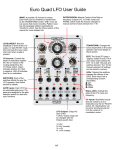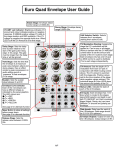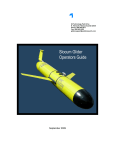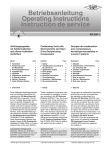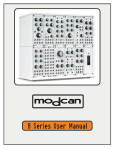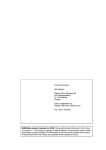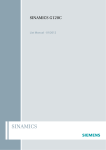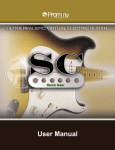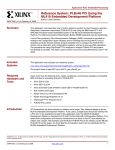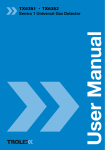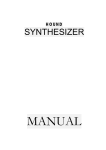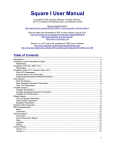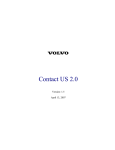Download User Manual.cdr - Analogue Haven
Transcript
Euro Quad LFO User Guide RATE/DIVISION: Manual Control of the Rate or frequency of each LFO. In SYNC mode and PHASE LOCK mode the function changes to manual control of clock division from 1-16 WAVE: A possible 16 choices for waves. Each wave can be morphed or transformed by the TRANSFORM Control. TAB1-3 has 32 sub waves that morph smoothly. Pattern wave has 32 pulse/gate patterns selectable by Transform control. See the Wave section of this manual for more detailed info. QUAD LFO LEVEL/RESET: Sets the amplitude or level of the LFO output. In Gate RSTST mode this knob sets the wave reset start point when a gate is present. LEVEL/RESET GATE Inputs: Each LFO has an associated gate input. The gates are assigned by the gate selection switch for reset and sync functions. G+ 6 7 8 9 10 5 4 3 2 CV AMOUNT 4LFO QUAD R PHLOCK G ROTATE Y MODE SWITCHES: Each of the switches effects the way the LFO operates. See Switch section for details. TRANSFORM TRANSFORM: Changes the waves dependent on the wave selected. See more details in Wave section. WAVE -R CV Amount: Controls the depth of modulation applied thru the CV inputs to the routing assigned by the CV Route switch. Green indicates positive CV, Red is negative. LED off indicates there is no modulation. PULSE STAIR UPDWN SLOPE CIRCLE RAND EXPO RCOS RISE TAB1 RSAW TAB2 SAW TAB3 SINE PAT TERN 16 1 5V 5V INV R 10V G 10V INV Y 2 RATE/DIV LOW R HIGH POLARITY RANGE/TAP 3 4 1 11 12 13 14 15 LFO EDIT RESET R RSTST G HOLD Y SYNC/TAP GATE FREQ R LEVEL G TRANS Y WAVE CV ROUTE SAVE EDIT: The QuadLFO uses a “paging” system to edit. The 4 way rotary switch selects the LFO 1-4 to edit. The pots and switches become “live” for the channel selected. All settings can be stored in memory. LEDs: Tapping the switches changes the colours of the LEDs. Each colour has a corresponding function associated. R G Y GATE1 GATE2 LFO1 CV LFO2 CV LFO3 CV LFO4 CV GATE3 GATE4 LFO1 LFO2 LFO3 LFO4 LFO Outputs: Output for each of the 4 LFOs. Output range can be changed with the Polarity switch from: 1/ 0-5V 2/ 5-0V inverted 3/ +/-5V 4/ -/+5V inverted pg1 =Off =Red =Green =Yellow Status LEDs: Indicate the state of the LFO cycle and frequency. CV Inputs: Modulation inputs that are routed to up to 4 destinations by the CV ROUTE switch. All 4 destinations can be active simultaneously per LFO for a total of 16 modulation routes. Button Switch Functions Mode Switch: The mode Switch has 4 options and is responsible for the most significant changes to the way the module operates. The modes and their functions are defined below. 4LFO: In this mode each of the 4 LFO function independently, each with their own frequency, wave, level and modulations. Changes to the parameters of each LFO is done by selecting the LFO to edit with the LFO EDIT rotary switch knob. The knobs become active and switch state LEDs update as each LFO is selected. This is the most typical mode when four separate LFOs is needed. Quad: Quad is short for Quadrature. LFO1 is the master in this mode and only LFO1 is editable. The module functions like a single LFO with 4 outputs in quadrature phase in this mode. LFO1s controls are global and editing panel controls are disabled for the other 3 LFOs. Outputs 2,3 and 4 are respectively 90, 180 and 270 degrees out of phase with LFO1 but are in sync. They use the same wave, frequency, level, CV routing etc as LFO1. This is a useful mode for quad panning or barberpole effects. Also makes an interesting gate sequencer when used with Pulse output waves. PHLOCK: Is Phase Locked mode. LFO1 sets the RATE or frequency for all 4 LFOs but each LFO can be a division of the master frequency. When editing LFO1 the RATE knob functions as it says. When editing LFOs 2-4 the RATE knob becomes the control for setting the division of the LFO1 master frequency. Each LFO can have a different wave, level etc. This can be a very unique mode especially when used with the last wave PATTERN. Each LFO can be outputting a different rhythm but all are in sync and can be different divisions. Makes a great generator for drum patterns. Rotate: Rotate mode functions the same as 4LFO mode with the exception being that pulses to the GATE1 input cause the LFOs to rotate to the right. For example after the first pulse LFO1 outputs on LFO2 out, LFO2 on output 3 LFO3 on output 4 and LFO4 on output 1. Each subsequent rotates this order 1 output to the right. This is a unique feature similar to feeding the 4 LFOs to a sequential switch module. Some very complex modulations are possible in this mode. SAVE: To save all edits depress and hold the MODE/SAVE button for approximately 2 seconds (count 1000 and 1, 1000 and 2 at a moderate pace). The row of coloured buttons will flash sequentially when button is release to indicate save was successful. If only the Mode LED changes colour the hold was too short. Polarity Switch: This switch is used to set the ouput range and inversion. There are 4 positions available. 5V: The output swings between 0 and 5V and doesn’t go negative. The LEVEL control can be used to reduce this range like a volume control. When level is at 0 the output is 0V 5V INV: Is the same 0-5V range but waves are inverted. A rising STAIR wave becomes a falling STAIR for example. 10V: The output swings between +5V and -5V. The LEVEL control can be used to reduce this range but in this case it does so symmetrical. For example at half level the output will be +/-2.5V. 10V INV: The output swings between +5V and -5V same as 10V setting. Once again the output is an inverted version of the above. Range Switch: The range switch sets the frequency or rate range for each LFO. The LOW range is .003Hz-51Hz and the HIGH range 10Hz-1.6kHz. The low range is used for typical LFO duties while the high range extends into the audio range ideal for FM modulation and also as a standalone audio source for drones etc. It is possible to control the pitch in this range with CV but it is not setup for accurate 1V/Oct tracking although it is possible to get close by adjusting the CV Amount. The morphing waves TAB1-3 can be an excellent source of audio textures in the high range. synchronized clocking is possible. In this mode the function of the RATE knob changes to DIVision. The possible divisions of the input clock are 1-16. The TAP button can be used instead to set the frequency in place of external clock. The division knob has no effect when using the TAP button to enter frequency. Tapping at least 3-4 times in a steady beat is best for accuracy. pg2 Switches Continued Gate Switch: The Gate switch selects how the LFOs will respond when a pulse/clock is patched to the GATE input jacks. There are 4 different responses available. Reset: This is a pretty straight forward function similar to hard sync on a VCO. Each pulse resets the LFO to the start of the waveform 0. RSTST: This mode is for Reset Start. This is similar to the RESET above but adds the capability to set the point at which the waveform resets from 0-100%. The panel control for this is the Level/Reset knob panel top left. In this Gate Mode the level has no effect having had its function replaced by Reset Start position. LFO amplitude is fixed at full scale or 100%. Also the LEVEL CV modulation routing is now used to control the waveform start as well. Having control over the Reset position in the waveform adds another unique dimension to shaping the way the LFOs cycle. Hold: In this Gate mode holding the gate input high FREEZES the LFO cycle position. When the gate returns to low state the LFO resumes cycling. Sync/Tap: The Sync mode functions like a frequency counter. Using a timer it calculates the time or period between pulses/clocks on the gate input jack and sets the LFO frequency to match. There is a separate gate input for each of the 4 LFOs so 4 different clocks can be used simultaneously. The RATE/DIV knob controls the division of the clock in this mode and is able to divide the sync clock from 1-16 divisions including odd values. The TAP button can also be used to set the frequency. Tapping 3 or 4 times at a steady pace to allow the timer to find an average is best for accuracy. The Rate/Division knob has no effect when tapping. CV Route Switch: The CV Route switch assigns the CV input jacks to the 4 destinations for internal modulation. Each of the 4 destinations can be modulated simultaneously. Even though only one LED colour is showing the other 3 can still be active. The CV AMOUNT knob controls the depth of modulation and the CV AMOUNT LED indicates the polarity of the modulation. GREEN= Positive+ and RED= Negative-. When LED is off the CV amount is 0 or none. The LED is also a handy indication of whether CV routing is active for a given Route selection. When stepping through the Routing switch destinations if the CV AMT LED is lit it is an indication that routing is assigned. If LED is off then no routing is assigned. Holding the CV ROUTE switch in a depressed state for 2 seconds will remove all CV Routings from the active LFO channel. This is a convenient way to get back to default state with all CV Routings OFF. Input Jacks: The range of input for the CV jacks is 0 - +/-5V. The high level pulse for the GATE inputs is ideally 5V but 10V will also work without damaging the module. WAVES LFO Waveforms: There are 16 waveforms to choose from using the WAVE selection knob. Each wave can be transformed or shaped in a manner that is different for each of the waves available. Please visit the web page http://www.modcan.com/emodules/quadlfowaves.html to see Oscilloscope screen captures that illustrate the effect of the TRANSFORM pot as it is rotated from 0 to fully clockwise. The same changes are also possible by assigning the CV input to TRANS. Think of it like an advanced Pulse Width Modulation feature on a standard LFO. The TAB1-3 contain 32 waves which are morphed smoothly with the transform control. The PATTERN wave uses the transform knob to select the 1-32 patterns. pg3



